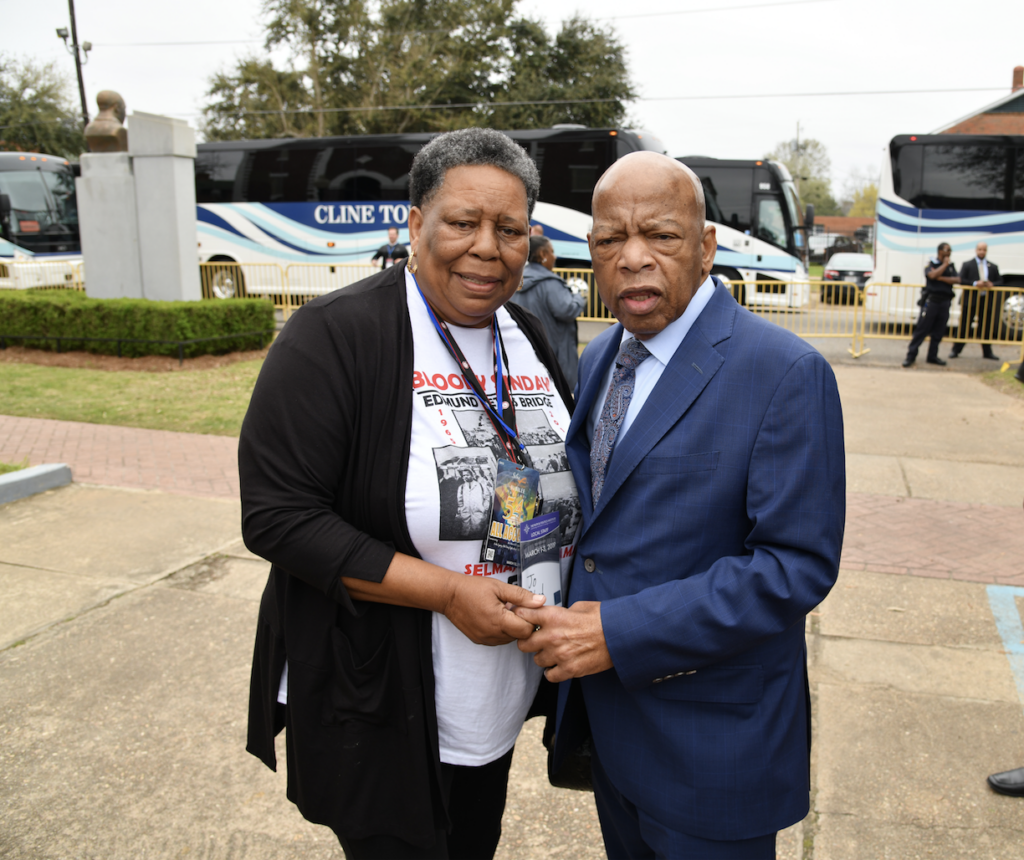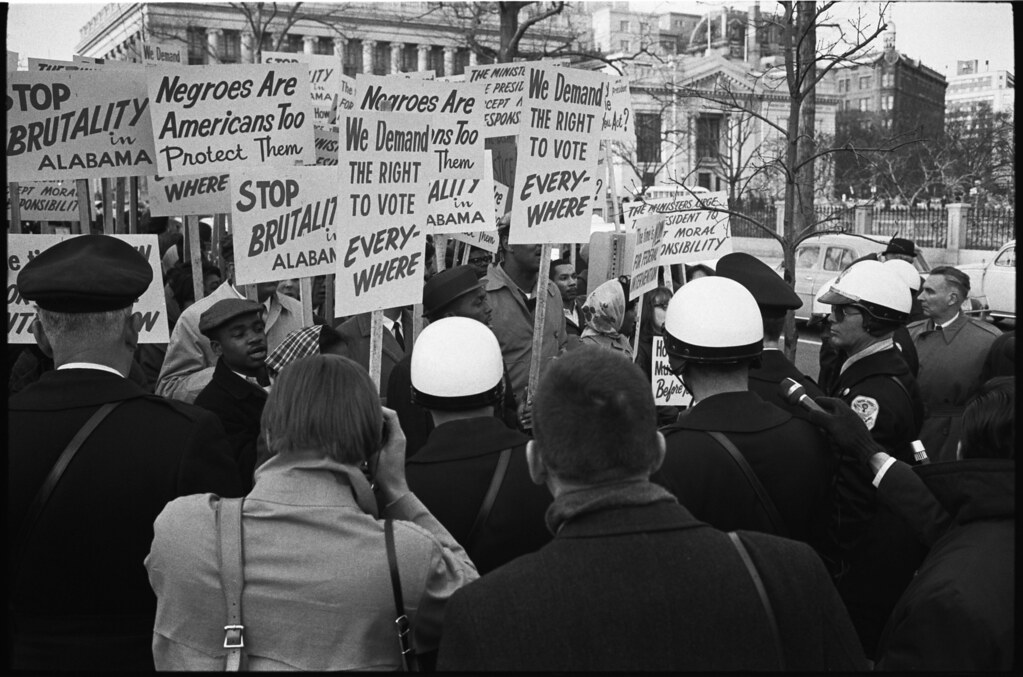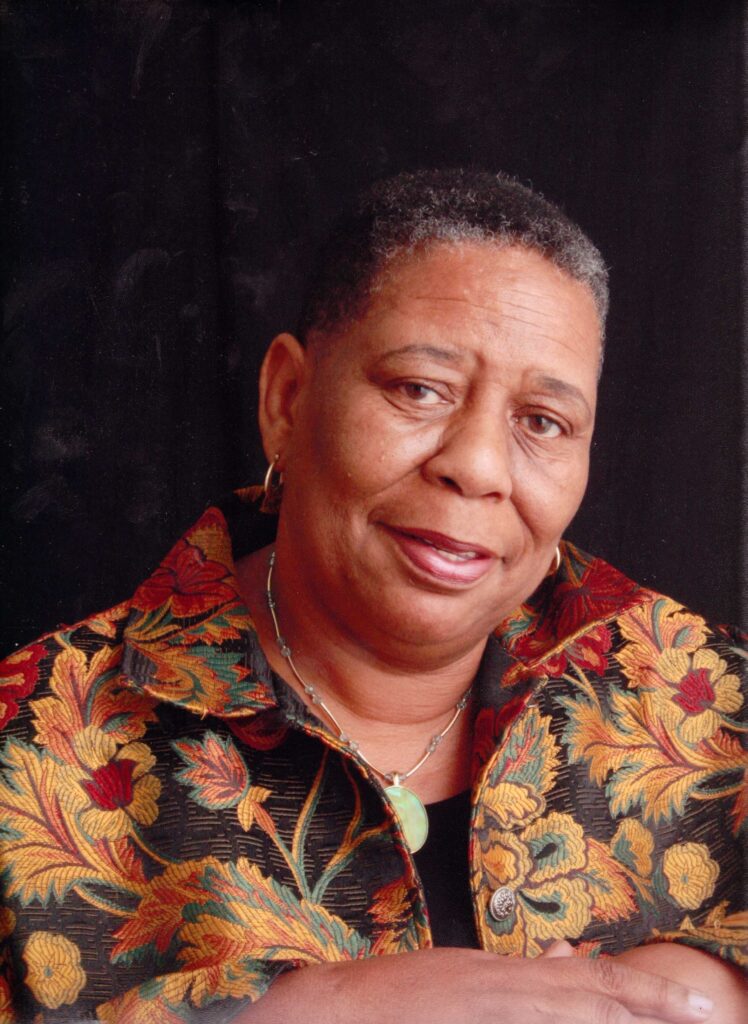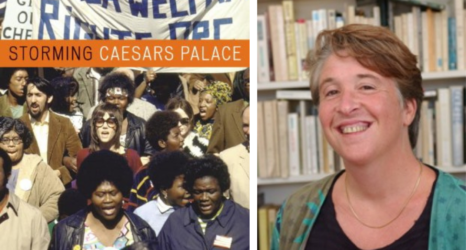In 2010, I was lucky enough to co-lead a Civil Rights Pilgrimage of college students from Wisconsin to the U.S. South and back to learn about the Civil Rights Movement. It was January and a busload of students and leaders made our way down to Atlanta, Montgomery, Birmingham, Memphis and back home to Milwaukee.
Along the way, we spent two days in Selma, Alabama. Little did we know what this visit had in store for us.

In Selma, our host was JoAnne Bland, founder of Journeys for the Soul tour company. Bland has a unique perspective and authority to give such a tour: She was 11 years old when she crossed the Edmund Pettus Bridge on March 7, 1965—a day that would come to be known as Bloody Sunday. She and her sisters were also there two days later on what is known as Turnaround Tuesday.
During our time in Selma, we learned about the history of the area and its importance in the Civil Rights Movement. We visited sites such as historic Brown Chapel AME Church, worked together in service of a local church and learning center, shared meals and heard from local leaders who told us their stories, showed us photos and shed tears with us. One of these men was Rev. Dr. Frederick D. Reese, pastor of Ebenezer Missionary Baptist Church, where we attended a service that Sunday.
On a walking tour of Selma, Bland took us to the National Voting Rights Museum (which she co-founded), by murals and monuments to John Lewis and others, and last, to a piece of cement in view of the Edmund Pettus Bridge. We stopped and she explained that we were standing where the group of over 600 people stopped on their fated march towards the bridge on Bloody Sunday.
On that spot, she told us of her fear, of the anticipation, and of the ordinary people about to change history that day. She told us to pick up a rock and hold it in our hands. She pointed to our rocks and said, “John Lewis stood on that rock,” or “You have Reverend Reese’s rock.” She even told one lucky student, “That one there was my rock.” We kept those rocks in our hands as she took us solemnly, two-by-two, across the Edmund Pettus Bridge. It was one of the most moving experiences of my life and one that I will never forget.
During the last few months, as COVID has ravaged the US and the world and thousands of people across the country have stood up in sustained protest against police brutality and racial injustice against Black citizens, I felt compelled to reconnect with JoAnne Bland to get her take on our current moment.
Karla J. Strand: So you were born and raised in Selma, Alabama, and you were involved in the Civil Rights Movement starting early on in childhood. How did that begin for you?
JoAnne Bland: My grandma. I was three when my mom died and my grandmother came to the funeral; she stayed to help rear us along with my dad. She had lived in the Midwest and had different ideas than most of the women around us. I grew up in George Washington Carver Homes here in Selma; it’s a housing project, but it wasn’t the housing project you know today. It was a whole different thing; it was a neighborhood and they were proud to even live there.
And we had no idea we were poor. I might’ve been the dumbest person in that generation [laughing], but I didn’t know we were poor. If anyone had asked me at that time to classify myself I would’ve said middle class; I didn’t know. Because we always had an abundance. We were never hungry. Everybody in the neighborhood shared. It was just a community, you know?
And Grandma, having lived in Detroit for like 35 years, she had some freedoms that we didn’t have in the South. She started talking to the women in the community about it and they introduced her to Mrs. [Amelia] Boynton. And Mrs. Boynton and her husband Sam had formed an organization to try to register African-Americans in the community to vote called the Dallas County Voters League. And Grandma would take us to the meetings and we had to sit there and listen quietly while they strategized on getting this thing called “freedom.”
Now personally, I thought they were the dumbest old people in America because I already knew that Abraham Lincoln freed the slaves; it was obvious they didn’t. And one day, I was downtown with my grandmother in Selma. Well, one of the shops had a lunch counter and I wanted to sit at the lunch counter, but my grandma said I couldn’t because it was for white children only. It didn’t stop me from wanting to sit at that counter.
Every time I passed by, I’d see those white kids in there and I’d be peeking in that window wishing it was me. One day, Grandma was talking to one of her friends in front of the store and I was looking in the window like I always do at those white kids wishing it was me and my grandmother noticed me looking in the window. And she leans over my shoulder, she pointed through the window to the counter and she said, “If we get our freedom, you can do that too.” I became a freedom fighter that day. That was when I understood the connection between voting and being able to sit at that counter. I wanted to sit at that counter and Grandma said if I had my freedom I could. So I started going down this church with my older sisters, down to First Baptist, to the meetings of SNCC [the Student Nonviolent Coordinating Committee]. And that’s how I got involved.
KJS: And you were around 8 you said at that time? And about 11 when Bloody Sunday occurred.
JB: Yeah.
KJS: So what do you recall from that time and how has it impacted you long-term?
JB: Oh man, [March 7, 1965] had to be the most terrifying day of my life. I’ve never experienced anything like it since and I hope not to ever again. The terror that I felt on that bridge turned into, as my sister can say, determination. I was determined even though I was afraid and on Turnaround Tuesday, I tried to [turn] back, but my sisters, thank God, wouldn’t let me. Because when I crested that bridge and saw the same scene [of state troopers], I was so terrified, I tried to go back. But [that day], nothing happened, we prayed and we turned around and came back. But after that, I was determined to do whatever I could to be a part of this.
In later years, I express it as being a part of the puzzle for social change. I became determined and it instilled in me that when I see injustice that I have to get up and do something. And I think that came from the way I grew up and experiencing what I experienced on that bridge.
KJS: I wonder how you’ve seen Selma change over time.
JB: I didn’t get a chance to sit at the counter. I think some young men decided to integrate it and [people] destroyed the store and when the store reopened they didn’t put it back in. But then I saw that my grandmother could go in stores and we didn’t have to go to the basement of some stores. We could go upstairs where the white people went, you know, there were actual laws to prevent us from doing things, so those laws changed. And I heard a white man call my grandmother Mrs. Johnson—”Mrs. Johnson, how you doing?” [laughing]—instead of by her first name as if they were her peers.
And then I left. I joined the Army and when I came back, I saw lots of changes. You know, there were businesses on Broad Street that were not only run by Blacks; they were owned by Blacks. But then after I was home for a while, they became surface changes to me, you know, the power was still in the hands of the oppressor. Now you allow me to rent one of your buildings so I can open a place—but the power still in the hands of the same people who made those laws for segregation? They still were in power making laws to hurt us. But I met people that were doing things in Selma to enlighten our people; that knew these were surface changes: “We want more than that, don’t you want more than that?”
We wanted to be a part of the power that made laws that affect our communities as well as their communities. If no power lies in the hands of the people who are represented in the city, then you still have a problem. And that’s the way it was in Selma when I came back home.
We had the same mayor for 36 years. The same mayor that was on the bridge in 1965 was the mayor when I came back to Selma. Go figure. So how could there be any real collective change? But I went to a city council meeting and the heads of the departments most of them were African American, you know, I was proud of that. I was proud of that when I realized they reported to the same mayor and that there were still many issues that affected our community. When you live here you realize that a lot has changed but not enough. Not enough.
We elected our first Black mayor in the year 2000, after 36 years of the same mayor. Then we had a fight about a Nathan Bedford Forrest monument. We were in the street just like in the ‘60s because Forrest was one of the worst slave owners to be because he bred human beings like cattle and sold them. He was a slave breeder, not the typical plantation owner; he was the worst kind. And he was also [the first Grand Dragon] of the Ku Klux Klan.
So as soon as we elected our first African-American mayor, this organization decided they would erect a monument to this man, this awful person in a town that was about 80 percent African American. And I personally was offended because look at the timing. If you study the history of these monuments that they’re talking about now and when they were erected, you will see that they were only done when there was some sort of either gain in the African American community or they were erected if we were out protesting and they knew they were going to lose that battle to so they put these statues up to intimidate. I [thought] every time I looked at that monument, they’re not honoring a hero. They said, “We may have a Negro mayor but we still here, okay?”
So they lost that battle because it was moved from one of the museums, where they dedicated it, to a cemetery that’s here in Selma, our oldest white cemetery. It was moved there and they were not happy, but it’s there. And we have people in Selma that say it shouldn’t even be there—but I decided that I have to pick my battles, you know, every battle is not yours. I felt like it’s in this cemetery, none of my relatives are out there, I don’t have to go out there and see an-y-thing. Anything. And I may be wrong for that, other people may disagree with that, but I see no reason that I have to go to that cemetery unless I want to. Unless I choose to.
Now, I don’t really disagree with people who say it shouldn’t be there. [But] moving that monument out of Selma will not change one heart here in Selma. Not one. You got to find a way to change hearts. You got to make people feel. That’s why I work so hard with my tours. When you come — and you’ve been here — I want you to feel it. I want you all these years later to do exactly what you did: still be thinking about it, still be doing what you’re supposed to be doing to further the agenda. You have to be in touch with this. You can’t just hear the history and not feel it. You have to connect to it. So I hope that’s what I do with my tour.
KJS: And so how do you feel about the current movement to remove Confederate statues and flags across the U.S.?
JB: I am so proud of the young people who are standing. They finally had enough. I believe this time, we’re going to go all the way. I really want to put that out: I am extremely proud of the young people of today for standing. And contrary to popular belief, most movements are fought by women and children—just as Selma, just as Birmingham, just as most of the movements in the United States. Dr. King may have been here I think six, seven times out of the whole period in Selma. The locals fought this battle. Dr. King was our inspiration and they were already fighting 30-some odd years before he came to Selma. He was invited to Selma to help and he brought what I call the three M’s: He brought money, motivation and the media. And then things got out.
Now the children today have managed to harness the media. Sometimes the media portrays them in different lights that aren’t really true; they villainized Black Lives Matter when it first came out. They became these hoodlums and thugs that were out there protesting. And after a while they got tired, I’m sure, of being villainized [but they] didn’t stop. And my heart was just glowing. I mean to look at those kids out there trying to do what’s right and saying they’re not gonna take it anymore, brought back the memories of the ‘60s. And when police attacked, it really took me straight back to that bridge, straight back to that bridge. How could this happen? To still be happening 55 years later, how can it? They’re still beating my people rather than making the world a better place for everybody. Something’s wrong with that whole picture.
But [I pray that] those children don’t stop. Don’t stop ‘til they get it right. The methods that we used in the ‘60s, I really don’t think would work for them today. I really don’t. But they need to know where we’ve been as a nation so that they can take us where we need to be. [pauses] And I think this is it. I feel hope that they’re gonna take us all the way this time. And I encourage them and I pray every day: Please don’t stop. Change will come if you keep their feet to the fire. Change will come.
And the tearing down of the statues, well, I think that young people have their ways of making change. And I shouldn’t discount them for doing that because it’s a method that I wouldn’t use, but I also don’t have a Confederate statue staring me in my face, okay? Mine’s in the cemetery [laughs]. But if it was in town square, I think I’d be the same way: Tear it down. Even though I truly believe that it doesn’t change any hearts by renaming and tearing down, it’s still progress to me.
Now there’s an issue about whether they should rename the Edmund Pettus Bridge. Now, I’m against it. I’m fighting this because I believe that it’s the only thing that Selma has. Selma has gone through so many changes, given so much to the world and the world ain’t give anything back—at all. Selma changed the whole face of this nation by fighting that fight for the right to vote. Yet, Selma didn’t progress from that—at all. People came, left, and that was it, okay?
And today we’re suffering from that. All we have today is tourism. The movie “Selma” gave tourism a great boost here, a great boost. And people spend billions of dollars each year going to these places, coming to see the bridge and walking across that bridge, particularly in these days and times because people are searching for answers, for answers. You should know this history. Nobody should be ignorant enough not to know this history. Selma should be the crown jewel of America. We changed the whole way of thinking in these United States and nobody gives a darn, you know?
Well, I’m fighting the name [change] because that name is synonymous with freedom, not just here in the United States, all over this world, and if we get rid of it, we gonna get rid of one of the main things that we do have that will attract people to Selma. We need the Edmund Pettus Bridge, okay, and we need it to be named Edmund Pettus. And I’m selfish, yeah, in my thinking because when you rename and renew, a new history begins and old history is forgotten.
No matter what you rename that bridge to, that old history going to just disappear in generations to come, mark my words. It always happens. It always happens. I learned years ago about the massacre in Oklahoma. But it wasn’t like it was taught in my school, you know, it was never brought up. So I had to do that myself. Somebody put it on some social media and I read it and I was appalled. Why didn’t I know this? How much more is hidden that I don’t know? Because when they changed that whole place, that history began. As soon as they took over that place, their history began. And the rest was just quietly put away. And nobody challenged it. So I don’t want that to happen to Selma.
There’s no industries lining up to come to Selma! I wish there were, but there aren’t. The reality is that they’re not, so what else do we have, okay? If the people in Selma and the people who were on that bridge in 1965 allow that, I think it would be a death knell for Selma.

KJS: So you don’t think people will come and be excited to visit if it were the John Lewis Bridge and there were plaques that would recognize the history?
JB: No. I want them to recognize the history as it was. When you come to Selma, I want you to get the true history of what it was. Besides, it’s an insult to us. I love John and John’s been my friend – uff – forever. And I heard that he didn’t want it anyway. John was not the only person on that bridge. Isn’t that a slap in the face to the people who were there too? That were beaten too? I just know that it would be a death knell for Selma. I truly believe that.
[Read what local Selma residents are saying about the renaming efforts of the Edmund Pettus Bridge.]
KJS: You talked about how a lot of the movements throughout history, really throughout the world, have been led by women and children. I wonder if you could speak to the importance of Black women’s leadership, especially in our current movement. We know that three Black women have founded Black lives matter, we know the #MeToo movement was founded by a Black woman—
JB: In my office! [laughing] Tarana Burke worked at [The Voting Rights Museum in Selma] when I was director. Yeah, she struggled, she struggled with that but, she wouldn’t let it go. I was so proud of her and still am; that’s my baby. Her and LaTosha Brown. LaTosha [created] Black Voters Matter so she’s doing her thing and I’d like to think I had a hand in both of those, okay? [laughing]
But make no mistake about it: Those ideas were totally theirs, totally. You see, that’s why I’m so proud of kids today. Because their way of thinking ain’t my way of thinking. I’m 66 years old, on the 29th of this month I’ll be 67—oh, I’m old, did I really say that? [laughing]—but I’ll be 67 years old. My method’s not gonna work for them! Young people ain’t gonna wait around for that and I don’t blame them. When I was a kid I wanted action and I wanted it now. And we live in the age of right now. So what happened for me ain’t gonna happen for them. I’m so proud of the ideas that they come up with, even with removing the name of the bridge. I’m glad a young person thought of that; that it offends them. I’m just glad that they’re thinking on their own, not taking the ideas and things that we did and trying to do them over again.
I want them to know the good things we did. I want them to know the things that didn’t work for us. Then improve upon what we had because I think we went for years, generations just reinventing the same thing. That is why it is important to know your history.

KJS: And you’re helping people learn the history with Journeys for the Soul. You’ve had this business since 2007. I wonder if you could say a little bit more about the tours that you offer but also how it’s changed now with COVID, and how you’ve been able to adapt.
JB: I’ve tuned in to modern technology. You know, Zoom and Google and all of that, but I’m still reaching out to people. I’m still doing what I’m supposed to do.
When I set up my tour agency, I wanted it to be unique. I wanted to immerse people in the history. I wanted them to see the sites, hear the stories, talk to people who were there. Children who even know a little bit about the Civil Rights Movement think that that was forever ago. This one little girl even asked me how it was to play with Harriet Tubman.
Even the older kids, a lot of them didn’t realize how recent this was. That we are still here. So when I set up my company, I decided that my claim to fame would be [that I was] a participant. I was there. When you come to Selma, you hear real stories; you hear the stories of the people who were there. And it took off. It worked. It worked not only business-wise, but it allowed me to do what I wanted to do: just keep this history and make it real.
So I take you on a journey. The name of my company is Journeys for the Soul and I take you on this journey. We go to these places and you hear what I experienced. Because we’re still here. We’re telling our stories and then it becomes alive, particularly to children. There’s a point in my tour [where I take people] to where we left from on what is now known as Bloody Sunday. We have an actual piece of that cement still there.
KJS: Yes, and I still have my rock!
JB: [Laughs] And you know! I [have you] pick up a rock and hold it in your hand. And then I name a few of those rocks. John Lewis stood on this rock. And then always somebody has my rock, you know that, someone has my rock. And we talk about the person and what happened right there before going to that bridge and being beaten by law enforcement officers. And you’re standing in the footprints of history-makers. Makes a whole lot of difference. [More] than me pointing at something and saying that’s where the Bloody Sunday March began and moving along. Makes a difference! So you have an actual piece of that history in your hand. And you connect to that. You connect to that.
You know, I have never seen anyone throw that rock down. I’ve seen people try to get more rocks [laughing], but I’ve never seen them throw that rock down. And I give them a mission: When you see injustice anywhere and you feel like you can’t do anything about it, you need to go pick up that rock. [Think of] the strength of the ordinary people who stood on that rock and made history that not only changed this town, but America. You get up off your behind and do something!
I travel all over these United States; everywhere I go, people have their rock. They have that rock and I tell them, put that rock where you can see it. Where you can see it every day. And people have that rock. Like you, you still have yours.
KJS: Yup. I do.
JB: Because you connected. You connected! And most young people—don’t tell them—but most young people already know the answers. They just don’t know they know the answers. So I had to learn to be a good listener. [laughing] And say the right words to encourage them to keep talking [and] they talk themselves to where they supposed to be because they already know. They just don’t know they know and they want affirmation. They know what they’re doing. They know where their piece is.
So I think I help with that too. I opened Journeys for the Soul and started doing the tours and I realized this was all I wanted to do. This is my piece in the puzzle for social change, you know? I truly believe that this is my piece, to do exactly what I’m doing.
And I truly believe that this generation is the one we’ve been waiting for. They’ll make it right.
KJS: What would you like to say about the election this year and the importance of voting?
JB: Well, besides continuing the protests, I think also everybody should be at the polls. Everybody get to the polls this time. We need to elect people who have our best interests at heart and I haven’t seen that in almost four years. I haven’t seen that so we gonna have to think about how we gonna be included in the process.
So you have to go to the polls. This may be the most important election of our lives. I can’t tell anybody who or what to vote for, that’s your personal right, but I was beaten on that bridge so you can have that right and it’s a slap in the face to me when you don’t go. I fought for you to have that right. And it’s a blatant show of disrespect when you don’t go.
Go to the polls. Make me proud.
****
JoAnne Bland and I spoke the morning of July 17. That afternoon, the news broke that Civil Rights icons Congressman John Lewis and Rev. C.T. Vivian had passed away. Here’s what she had to say about their loss:
“I am sad. But I feel extremely rich that I was touched by both C.T. and John.”
****
This interview has been edited for length and clarity.





